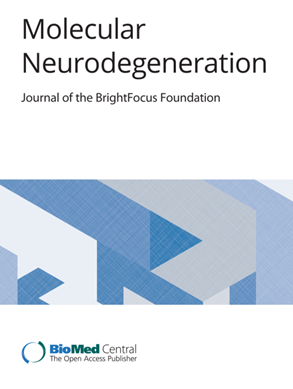Clinical progression and genetic pathways in body-first and brain-first Parkinson’s disease
IF 17.5
1区 医学
Q1 NEUROSCIENCES
引用次数: 0
Abstract
Parkinson’s disease (PD) is a highly heterogeneous disorder with distinct phenotypes that can develop well before motor symptoms appear. Recently, two main phenotypes based on the different pathological spreading patterns of PD have been proposed: “body-first”, where α-synuclein pathology begins in the peripheral nervous system and spreads symmetrically from bottom-up, and “brain-first”, where pathology starts in the brain and spreads asymmetrically downwards. However, no studies have assessed these phenotypes across both prodromal and clinical PD stages, tracked their pathological progression in vivo or identified potential underlying biological mechanisms. To address this, we analyzed 910 prodromal and 1120 clinical PD cases with comprehensive longitudinal clinical, imaging, and genetic data from the Parkinson Progression Marker Initiative over a 12-year period. Our findings revealed that both prodromal and clinical groups with body-first symptoms exhibited greater motor dysfunction, anxiety, and depression at baseline; as well as worse longitudinal motor progression and attention decline compared to brain-first cases. The body-first and brain-first phenotypes were stable over time and predicted conversion to clinical PD in prodromal cases, and were also found using unsupervised deep learning analyses. Additionally, body-first cases displayed more pronounced changes in the caudal LC, as well as symmetrical alterations in the striatum and glymphatic system, consistent with the traditional bottom-up progression described by Braak’s staging of α-synuclein pathology and the more symmetric distribution proposed for body-first PD. In contrast, brain-first cases exhibited changes in the rostral LC and asymmetric alterations in the striatum and glymphatic system, suggesting a top-down progression. Genetic analysis also identified new specific single nucleotide polymorphisms associated with PD phenotypes, such as TRIM40 and IP6K2, linked to worse motor and cognitive outcomes in prodromal cases. These findings emphasize the importance of recognizing body-first and brain-first PD as distinct entities with unique clinical, imaging, and genetic profiles, paving the way for targeted and personalized therapeutic strategies that address the specific pathophysiological mechanisms of PD.身体优先和大脑优先帕金森病的临床进展和遗传途径
帕金森病(PD)是一种具有不同表型的高度异质性疾病,可以在运动症状出现之前发展。最近,基于PD不同的病理扩散模式,提出了两种主要的表型:“体优先”,即α-突触核蛋白病理从周围神经系统开始,自下而上对称扩散;“脑优先”,即病理从大脑开始,向下不对称扩散。然而,目前还没有研究评估PD前驱和临床阶段的这些表型,追踪它们在体内的病理进展或确定潜在的生物学机制。为了解决这个问题,我们分析了910例前驱和1120例临床PD病例,并从帕金森进展标志物倡议中获得了12年的综合纵向临床、影像学和遗传数据。我们的研究结果显示,无论是前驱症状组还是有身体优先症状的临床组,在基线时都表现出更大的运动功能障碍、焦虑和抑郁;同时纵向运动进展和注意力下降也比脑优先病例更严重。随着时间的推移,身体优先和大脑优先的表型是稳定的,并且预测了前驱病例向临床PD的转化,并且还使用无监督深度学习分析发现。此外,体优先病例在尾侧LC中表现出更明显的变化,纹状体和淋巴系统也表现出对称的改变,这与Braak α-突触核蛋白病理分期所描述的传统自下而上的进展相一致,也与体优先PD的更对称分布相一致。相比之下,脑优先病例显示吻侧LC的变化和纹状体和淋巴系统的不对称改变,表明自上而下的进展。遗传分析还发现了与PD表型相关的新的特异性单核苷酸多态性,如TRIM40和IP6K2,与前驱病例中更差的运动和认知结果有关。这些发现强调了将身体优先和大脑优先的PD视为具有独特临床,影像学和遗传特征的不同实体的重要性,为针对PD的特定病理生理机制的靶向和个性化治疗策略铺平了道路。
本文章由计算机程序翻译,如有差异,请以英文原文为准。
求助全文
约1分钟内获得全文
求助全文
来源期刊

Molecular Neurodegeneration
医学-神经科学
CiteScore
23.00
自引率
4.60%
发文量
78
审稿时长
6-12 weeks
期刊介绍:
Molecular Neurodegeneration, an open-access, peer-reviewed journal, comprehensively covers neurodegeneration research at the molecular and cellular levels.
Neurodegenerative diseases, such as Alzheimer's, Parkinson's, Huntington's, and prion diseases, fall under its purview. These disorders, often linked to advanced aging and characterized by varying degrees of dementia, pose a significant public health concern with the growing aging population. Recent strides in understanding the molecular and cellular mechanisms of these neurodegenerative disorders offer valuable insights into their pathogenesis.
 求助内容:
求助内容: 应助结果提醒方式:
应助结果提醒方式:


